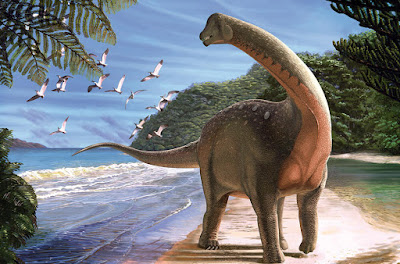Scientists have unearthed in a Sahara Desert oasis in Egypt fossils of a long-necked, four-legged, school bus-sized dinosaur that lived roughly 80 million years ago, a discovery that sheds light on a mysterious time period in the history of dinosaurs in Africa.
Researchers said on Jan. 29 the plant-eating Cretaceous Period dinosaur, named Mansourasaurus shahinae, was nearly 10 meters long and weighed 5.5 tons and was a member of a group called titanosaurs that included Earth's largest-ever land animals. Like many titanosaurs, Mansourasaurus boasted bony plates called osteoderms embedded in its skin.
Mansourasaurus, which lived near the shore of the ancient ocean that preceded the Mediterranean Sea, is one of the very few dinosaurs known from the last 15 million years of the Mesozoic Era, or age of dinosaurs, on mainland Africa. Madagascar had a separate geologic history.
Its remains, found at the Dakhla Oasis in central Egypt, are the most complete of any mainland African land vertebrate during an even larger time span, the roughly 30 million years before the dinosaur mass extinction 66 million years ago, said paleontologist Hesham Sallam of Egypt's Mansoura University.
The scientists recovered parts of its skull, lower jaw, neck and back vertebrae, ribs, shoulder and forelimb, back foot and osteoderms.
 |
A lot of Africa is covered in grasslands, savannas and rain forests that obscure underlying rock where fossils may be found, said postdoctoral researcher Eric Gorscak of the Field Museum in Chicago, who was formerly at Ohio University.
While as massive as a bull African elephant, Mansourasaurus was modestly sized next to titanosaur cousins such as South America's Argentinosaurus, Dreadnoughtus and Patagotitan and Africa's Paralititan, some exceeding 30 meters long.














No comments:
Post a Comment